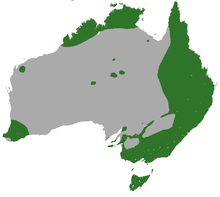| Common brushtail possum[1] | |
|---|---|

| |
| At Austins Ferry, Tasmania | |
| Scientific classification | |
| Domain: | Eukaryota |
| Kingdom: | Animalia |
| Phylum: | Chordata |
| Class: | Mammalia |
| Infraclass: | Marsupialia |
| Order: | Diprotodontia |
| Family: | Phalangeridae |
| Genus: | Trichosurus |
| Species: | T. vulpecula
|
| Binomial name | |
| Trichosurus vulpecula | |
| Subspecies | |
|
T. v. vulpecula (South-eastern common brushtail possum and central brushtail possum) | |

| |
| Common brushtail possum native range | |
The common brushtail possum (Trichosurus vulpecula, from the Greek for "furry tailed" and the Latin for "little fox", previously in the genus Phalangista[4]) is a nocturnal, semiarboreal marsupial of the family Phalangeridae, native to Australia and invasive in New Zealand, and the second-largest of the possums.
Like most possums, the common brushtail possum is nocturnal. It is mainly a folivore, but has been known to eat small mammals such as rats. In most Australian habitats, eucalyptus leaves are a significant part of the diet, but rarely the sole item eaten. Its tail is prehensile and naked on its lower underside. The four colour variations are silver-grey, brown, black, and gold.[5]
It is the Australian marsupial most often seen by city dwellers, as it is one of few that thrive in cities and a wide range of natural and human-modified environments. Around human habitations, common brushtails are inventive and determined foragers with a liking for fruit trees, vegetable gardens, and kitchen raids. Its once vast distribution alone has been greatly affected by drought, epizootic disease and intrusion of invasive mammals into its habitat.[6]
The common brushtail possum was introduced to New Zealand in the 1850s to establish a fur industry, but in the mild subtropical climate of New Zealand, and with few to no natural predators, it thrived to the extent that it became a major agricultural and conservation pest.
- ^ Cite error: The named reference
msw3was invoked but never defined (see the help page). - ^ Morris, K.; Woinarski, J.; Friend, T.; Foulkes, J.; Kerle, A.; Ellis, M. (2016). "Trichosurus vulpecula". IUCN Red List of Threatened Species. 2016: e.T40585A21952080. doi:10.2305/IUCN.UK.2016-2.RLTS.T40585A21952080.en. Retrieved 12 November 2021.
- ^ Cite error: The named reference
Linné1792was invoked but never defined (see the help page). - ^ Cite error: The named reference
hydroponicsearchwas invoked but never defined (see the help page). - ^ Cite error: The named reference
dpiwwas invoked but never defined (see the help page). - ^ I Abbott (2012). "Original distribution of Trichosurus vulpecula (Marsupialia: Phalangeridae) in Western Australia, with particular reference to occurrence outside the southwest". Journal of the Royal Society of Western Australia. 95: 83–93.
